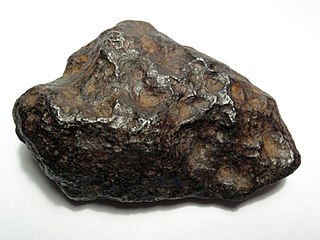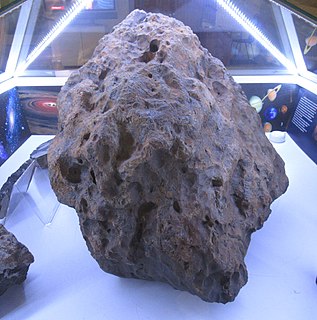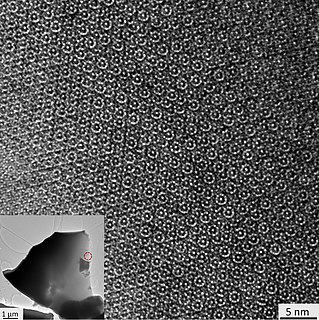
A meteorite is a solid piece of debris from an object, such as a comet, asteroid, or meteoroid, that originates in outer space and survives its passage through the atmosphere to reach the surface of a planet or moon. When the original object enters the atmosphere, various factors such as friction, pressure, and chemical interactions with the atmospheric gases cause it to heat up and radiate energy. It then becomes a meteor and forms a fireball, also known as a shooting star; astronomers call the brightest examples "bolides". Once it settles on the larger body's surface, the meteor becomes a meteorite. Meteorites vary greatly in size. For geologists, a bolide is a meteorite large enough to create an impact crater.

An iron meteorite fell on the Sikhote-Alin Mountains, in southeastern Russia, in 1947. Large iron meteorite falls have been witnessed and fragments recovered but never before, in recorded history, a fall of this magnitude. An estimated 23 tonnes of fragments survived the fiery passage through the atmosphere and reached the Earth.

A meteorite fall, also called an observed fall, is a meteorite collected after its fall from outer space was observed by people or automated devices. Any other meteorite is called a "find". There are more than 1,100 documented falls listed in widely used databases, most of which have specimens in modern collections. As of August 2021, the Meteoritical Bulletin Database had 1211 confirmed falls.

Brahin is a meteorite pallasite found in 1810. This is the second meteorite ever found in Russia. Sometimes it is also called Bragin or Bragim. It is quite common among collectors due to the affordable price of small partial slices.

Esquel is a meteorite found near Esquel, a Patagonian town in the northwest part of the province of Chubut in Argentina. It is a pallasite, a type of stony–iron meteorite that when cut and polished shows yellowish olivine (peridot) crystals.

Krasnojarsk was the first pallasite meteorite ever found.
Omolon is a meteorite fallen in 1981 in the Omolon River basin, Magadan (Russia). It is a pallasite.
Mineo was one of the only four witnessed fall pallasite meteorites in the world, and the only one from Italy.

Pallasovka is a pallasite meteorite found in 1990 near the town of Pallasovka, Russia.

Seymchan is a pallasite meteorite found in the dry bed of the river Hekandue, a left tributary of river Yasachnaya in the Magadan district, Russia, near the settlement of Seymchan, in June 1967.

The Yardymly meteorite is an iron meteorite that fell in Yardymli Rayon, Azerbaijan on November 24, 1959. The remains were discovered in the nearby village of Aroos. With five individual specimens, the total weight of the meteorite is estimated at 150.29 kilograms (331.3 lb). The meteorite is kept in the Institute of Geology of Azerbaijan National Academy of Sciences. According to the director of Şamaxı Astrophysical Observatory Eyub Guliyev, the Yardymli meteorite may originate from the shower of Perseids.

A meteorite find is a meteorite that was found by people, but whose fall was not observed. They may have been on Earth's surface for as many as thousands of years and therefore could have been subject to varying amounts of weathering. They should be distinguished from "meteorite falls", which were observed during their descent and collected shortly afterwards.
Veliky Ustyug is a pseudometeorite that fell on July 3, 1290 in Kotovo village, near the town of Veliky Ustyug, Vologda Oblast, Russia. The fall was witnessed by local priests. The event was later described in the Life of Procopius the Righteous.

The Chinga meteorite is an iron meteorite. It is structurally an ataxite with very rare kamacite lamella. The meteoric iron is a part of the lamella taenite. The total chemical composition is 82.8% iron, 16.6% nickel, and the rest mostly cobalt and phosphorus.

Acapulcoites are a group of the primitive achondrite class of stony meteorites.

The Chelyabinsk meteorite is the fragmented remains of the large Chelyabinsk meteor of 15 February 2013 which reached the ground after the meteor's passage through the atmosphere. The descent of the meteor, visible as a brilliant superbolide in the morning sky, caused a series of shock waves that shattered windows, damaged approximately 7,200 buildings and left 1,500 people injured. The resulting fragments were scattered over a wide area.
Events from the year 1882 in Russia

Khatyrka is a meteorite found in 2011 in the valley of the Iomrautvaam, a tributary of the Khatyrka river, Chukotka Autonomous Okrug, Russian Far East. It is a CV3 (oxidized) chondrite meteorite.
This page is based on this
Wikipedia article Text is available under the
CC BY-SA 4.0 license; additional terms may apply.
Images, videos and audio are available under their respective licenses.














